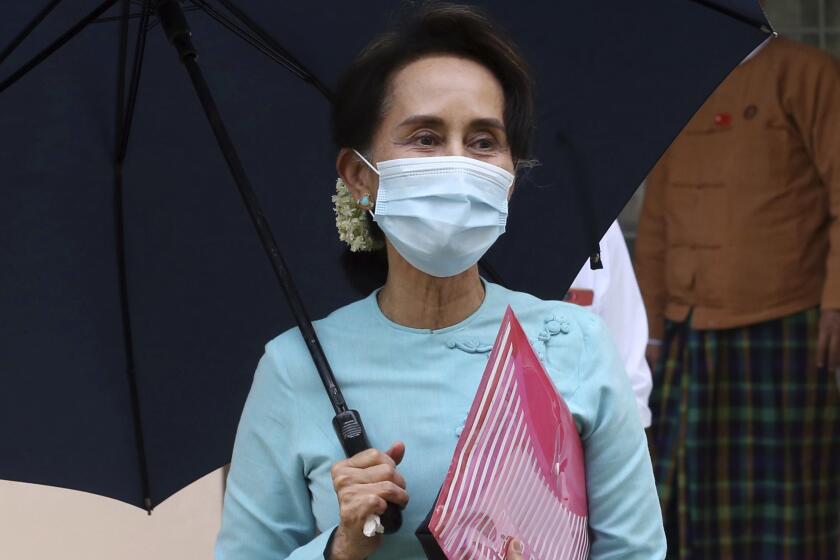Myanmar’s ethnic insurgents raise the pressure on military junta
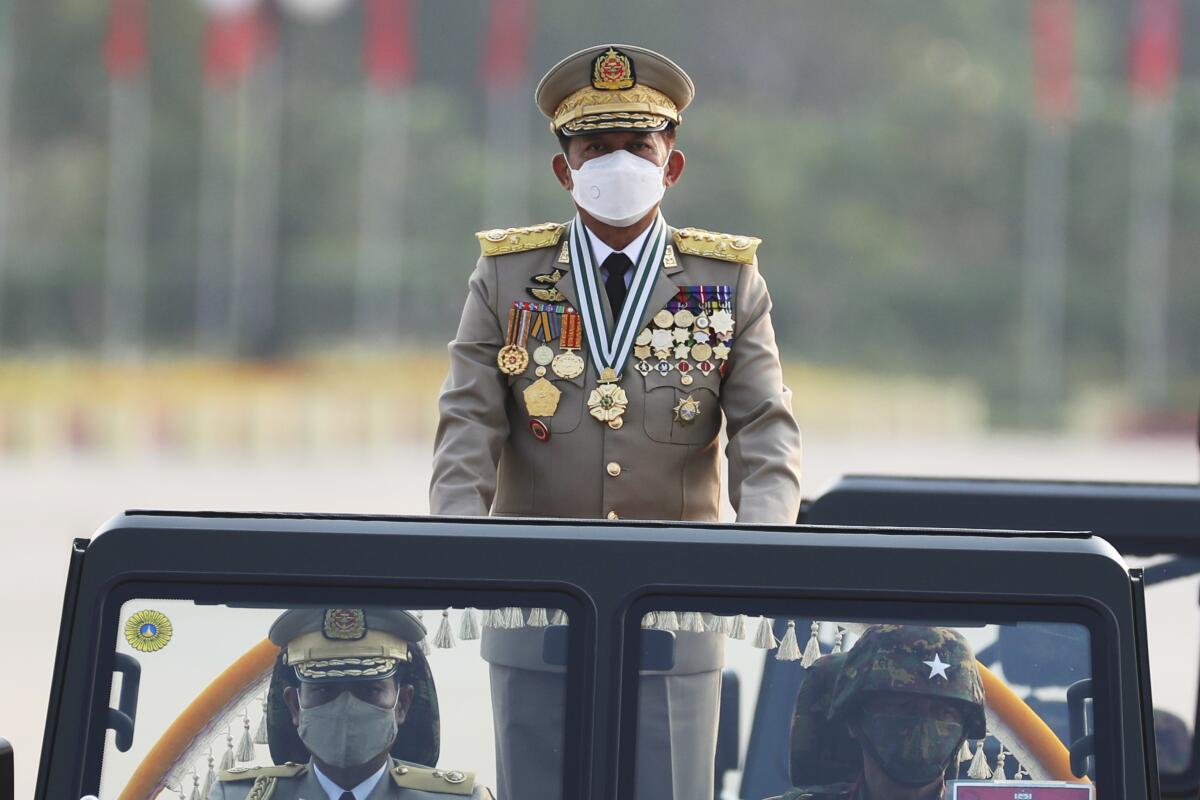
- Share via
CHIANG MAI, Thailand — The day her 4-year-old grandson was killed, U San Yee had taken him to their local market in rural Myanmar for sticky rice and his favorite fried banana snacks before coming home to play with his toy cars.
“We didn’t know that the Myanmar military would fire artillery shells,” U San Yee said. “That’s why we were just going about and living our normal lives.”
When the first explosions struck Kin Seik, a farming village of about 3,000 people, the two were watching “Tom and Jerry” cartoons.
“We tried to run to another place, but on the way a shell fell on my grandson and his mother while they were holding hands,” said U San Yee, who could only watch as the boy bled to death and his mother was wounded.
Three civilians were killed and eight others injured in the Aug. 28 attack on the community of bamboo houses on the fertile plains of the country’s western Rakhine state. It was one of a series of deadly assaults that marked the collapse of an 18-month cease-fire between the military and the Arakan Army, one of the country’s most powerful ethnic insurgent groups.
The detentions come after days of escalating tension between Aung San Suu Kyi’s National League for Democracy and Myanmar’s powerful military.
Nearly 22 months after the country’s military overthrew a democratically elected civilian government led by Nobel laureate Aung San Suu Kyi, it is now fighting a war on multiple fronts.
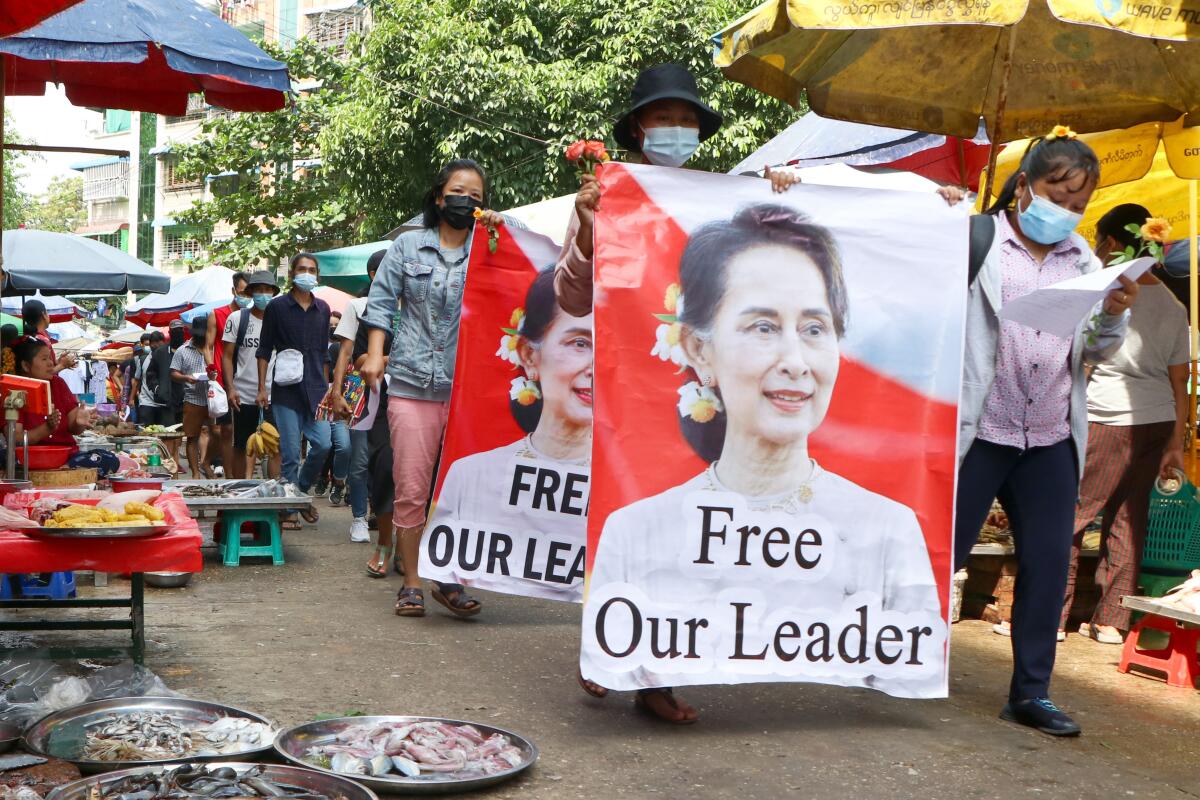
More than 7,000 civilians have been killed since the coup, according to the Institute for Strategy and Policy, a Yangon-based think tank. Victims include protesters shot in the head, dissidents killed in detention and villagers bound and burned alive.
But as the renewed fighting in Rakhine reflects, the military, which has ruled Myanmar with an iron grip for much of the last half century, remains unable to re-consolidate power.
In one of the latest examples of violence, military jets bombed a concert in northern Kachin state on Oct. 23, killing at least 80 people, including civilians and members of the ethnic Kachin Independence Army.
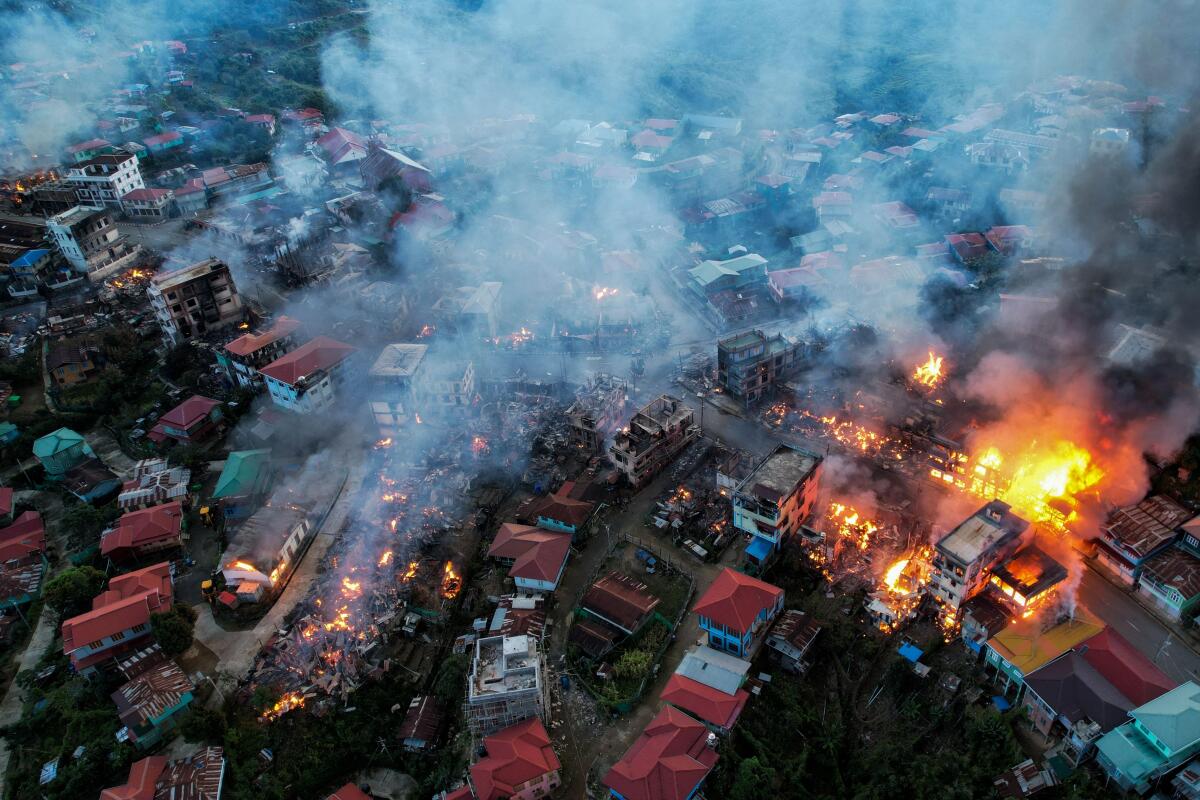
Meanwhile, dozens of junta soldiers have reportedly been killed since late October in Rakhine, northwestern Karen state and the central city of Mandalay.
The junta has increasingly resorted to air power because of growing losses to infantry on the ground from ambushes and roadside bombs.
“The military is getting desperate,” said Kyaw Zaw, a spokesman for the National Unity Government, a parallel government filled with deposed civilian lawmakers working to dislodge the junta. “Their only strategy is to terrorize the population by targeting defenseless civilians.”
The junta is now confronting newly formed rebel groups such as the disparate People’s Defense Force aligned with the parallel government, and an increasing number of ethnic armed groups based in the country’s border regions.
Western sanctions and diplomatic pressure have done little to stanch the bloodshed — a civil war raging in the heart of Asia on the doorstep of two geopolitical giants, India and China.
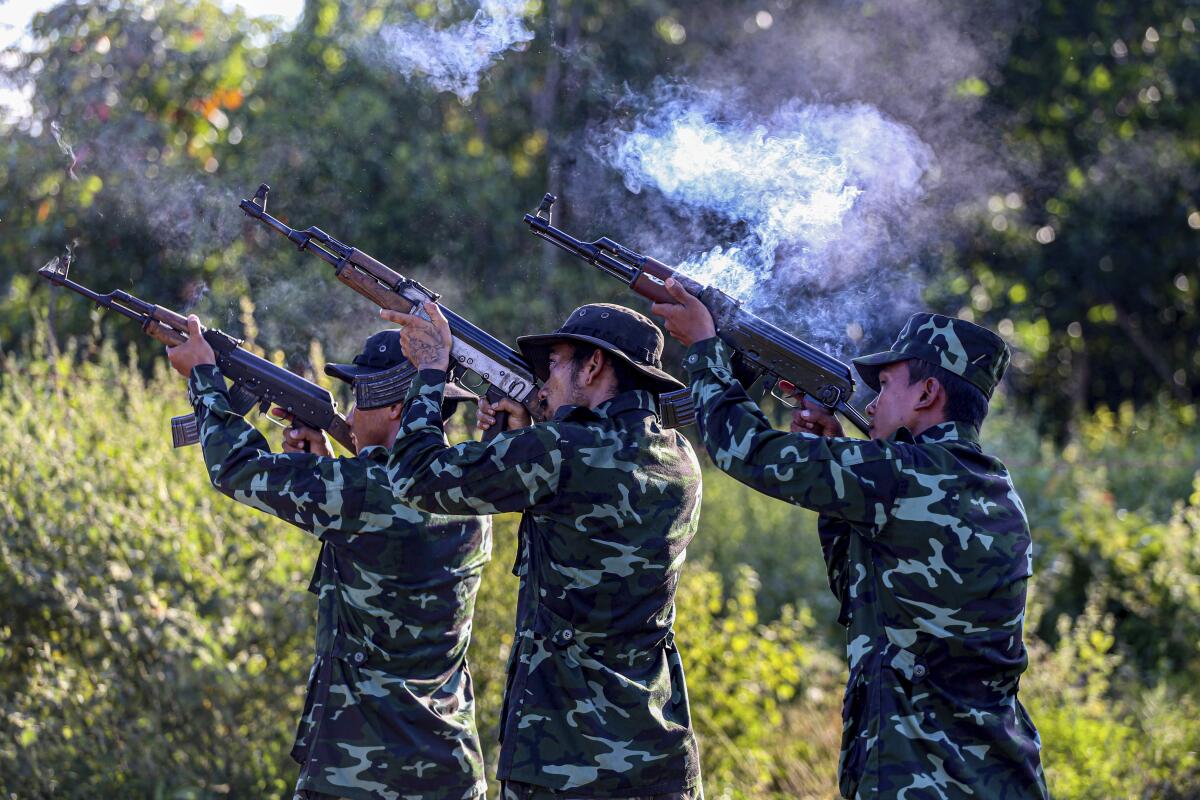
Immediately following the coup, the new junta was confronted by mass protests that were brutally quashed with a series of urban massacres, propelling many of Myanmar’s youth to seek training and weapons from the country’s myriad ethnic armed groups. In September 2021, the parallel government declared a “people’s defensive war” to overthrow the military, forging formal alliances with some of the ethnic rebels.
Initially given little chance of resisting a military equipped with warplanes and heavy artillery, the insurgents have inflicted enough damage to keep the junta hopping. As a result, it is showing signs of stress. Casualties are rising and combat-ready replacements are scarce. Defections and poor pay are reportedly contributing to sinking morale.
If more ethnic armed groups like the Arakan Army join the fight against the military, known as the Tatmadaw, experts say it could eventually tip the scales in the civil war.
“The junta expected to readily subsume the country into its control with its brutal coercive power, but it has failed so far,” said Ye Myo Hein, a political scientist at the Wilson Center. “It has lost its consolidated control over a vast swath of territory across the country.”
“It’s hard to predict what will happen next,” he added, “but one thing is certain: the junta is losing ground.”
Myanmar, also known as Burma, has long been fractured along ethnic lines and dominated by the majority Buddhist Bamars who reside in the largest cities. The Southeast Asian nation roughly the size of Texas is home to more than 100 different ethnic groups, some of whom were fighting for autonomy even before Myanmar won independence from Britain in 1948.
One of those groups is the Rakhine, also known as the Arakanese. Despite being overwhelmingly Buddhist and speaking a language closely related to the Burmese used by Bamars, the Rakhine have long maintained a fierce separatist streak. Rakhine existed as an independent kingdom until it was conquered by the Burmese in 1785 and is isolated from the rest of the country by a rugged mountain range.
“We want our Rakhine state to be independent — it is the dream of every Rakhine person,” said a 32-year-old farmer in Maungdaw township, which has also seen heavy fighting in recent months, who asked to remain anonymous for safety reasons.
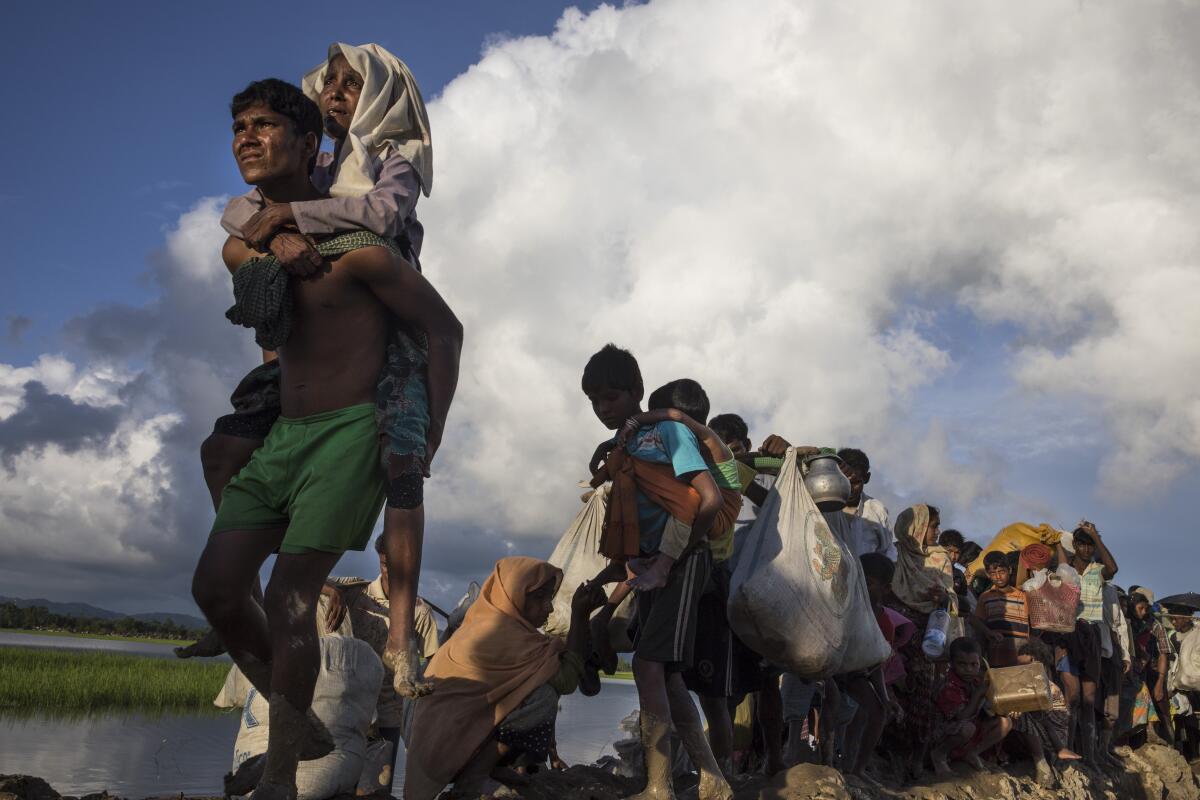
That staunch Rakhine-Buddhist identity contributed to one of the worst chapters in modern Burmese history when many Rakhine supported the Tatmadaw’s so-called “clearance operations” in 2017, forcing more than 750,000 Rohingya Muslims in Rakhine across the border into Bangladesh.
The United Nations said the crackdown was “a textbook example of ethnic cleansing.” Suu Kyi, who was under house arrest by the military for 15 years before winning landslide election victories in 2015 and 2020, refused to condemn the attacks and defended the military at the International Court of Justice in 2019, leading to her disgrace as a human rights figure. Since the junta took back control in early 2021, she has been imprisoned in the nation’s capital.
It was in the wake of the junta’s campaign against the Rohingya that fighting between the Arakan Army and the military worsened. Formed in 2009, the self-proclaimed 30,000-member force seeks self-determination for the Arakanese people and is represented by its political wing, the United League of Arakan. The group’s foot soldiers have fought a guerrilla war against government security forces, ambushing military outposts and police stations.
Weary of the attacks, the government agreed to a cease-fire in November 2020. Analysts speculate the agreement was struck so that the military could prepare for the coup. The Arakan Army used the lull in fighting to consolidate more territory.
The truce would prove fleeting. Heavy fighting returned to Rakhine in July of this year, when the Arakan Army ambushed a column of the paramilitary Border Guard Police. The strike was in response to the military’s arrest of supporters and members of the Arakan Army’s civilian administration. Clashes quickly spread across Rakhine, including in Maungdaw, near the Bangladesh border; Mrauk-U, the Arakan Kingdom’s ancient capital; and Taungup, near a southern beach vacation destination. Paletwa, in neighboring Chin state, also saw fighting.
The Maungdaw farmer who spoke to The Times said there had been no fighting in his area for years. But since mid-August, he frequently goes to bed to the steady sound of shelling and fighter jets, wondering if his village will be bombed.
Kyaw Lynn, an ethnic Rakhine political analyst, said the fighting in Maungdaw underscores the Arakan Army’s desire to seize control of the border with Bangladesh, which is important both for economic reasons and issues of sovereignty.
To burnish its legitimacy, the Arakan Army has tried to forge a better relationship with Bangladesh by presenting itself as a more reliable partner than the junta in handling the Rohingya refugee crisis. More than 900,000 Rohingya are living in squalid camps in Bangladesh, putting a massive strain on the impoverished country. An effort to repatriate many of the refugees has repeatedly faltered under the military.
“The international community, including the Bangladeshi government, has to recognize the United League of Arakan as a key stakeholder in trying to resolve this” crisis, Khaing Thu Kha, a spokesman for the Arakan Army, said at a news conference in September.
Whether the Arakan Army can achieve autonomy may hinge on its burgeoning relationship with the National Unity Government. Formed after the coup by a group of lawmakers elected in the 2020 polls, it includes many former National League for Democracy officials. While some of its officials are based abroad, other leaders remain in Myanmar where they’ve begun rolling out public services in anti-military strongholds. Schools, police forces and healthcare clinics are up and running, typically manned by civil servants who went on strike in protest of the coup.
Unlike other armed groups, the Arakan Army has refused to pledge loyalty to the opposition forces because of tensions in the past with Suu Kyi and her party. In 2019, a National League for Democracy official referred to the Rakhine insurgents as “terrorists.” The following year, the Arakan Army justified abducting three National League for Democracy parliamentary candidates by accusing the party of cooperating with the Tatmadaw.
Now presented with a common enemy, the relationship has thawed. The Arakan Army met with the National Unity Government in May, while rejecting an invitation for peace talks from the junta. At the meeting, Khaing Thu Kha said the Arakan Army would “open the door” to cooperation, but reiterated the demands for autonomy — something the National Unity Government is reluctant to grant for fear that other ethnic armed groups will make similar demands.
As long as the junta remains in power, the people of Rakhine will likely struggle to reconcile their desire for self-determination with support for a shadow government stacked with Suu Kyi’s acolytes.
“Yes, I want the NUG to overthrow the military. But personally, I want our people to control our state,” the Maungdaw farmer said. “I want this to be the final war in Rakhine.”
Special correspondents Kyaw Hsan Hlaing reported from Washington and Nachemson from Chiang Mai, Thailand. Times staff writer David Pierson in Singapore contributed to this report.
More to Read
Sign up for Essential California
The most important California stories and recommendations in your inbox every morning.
You may occasionally receive promotional content from the Los Angeles Times.
